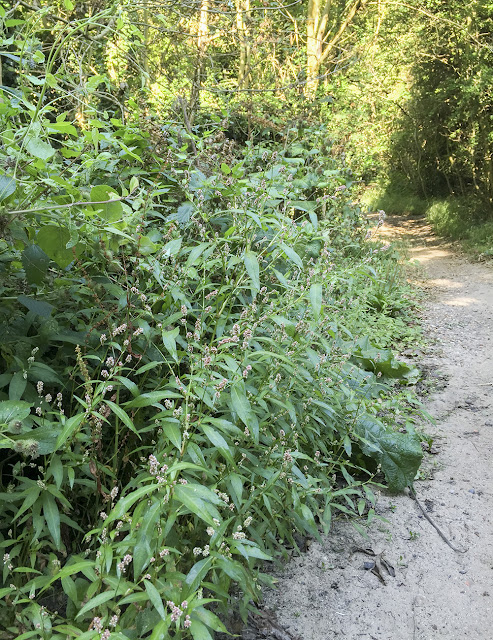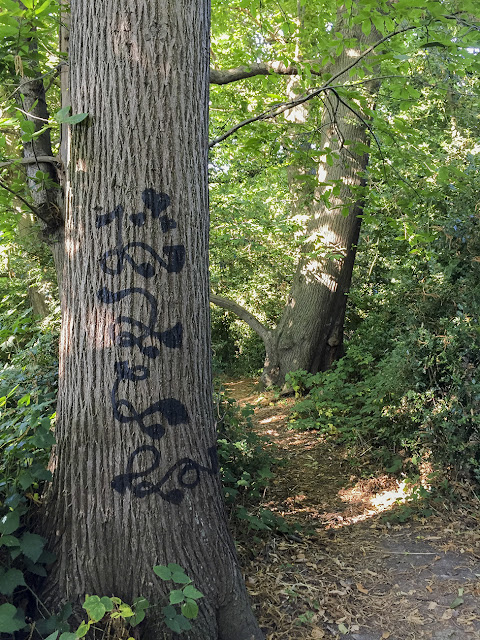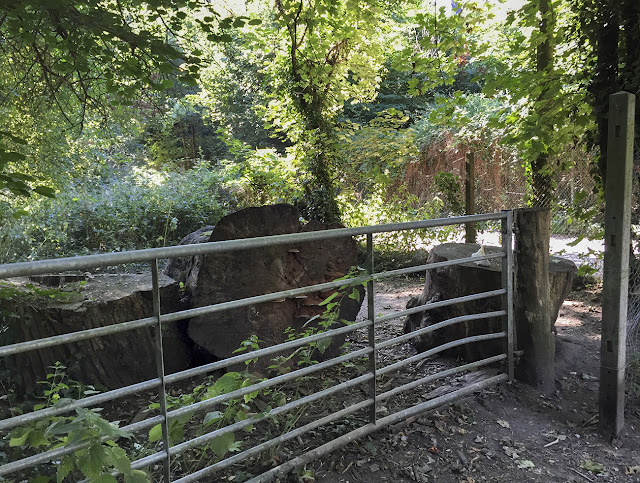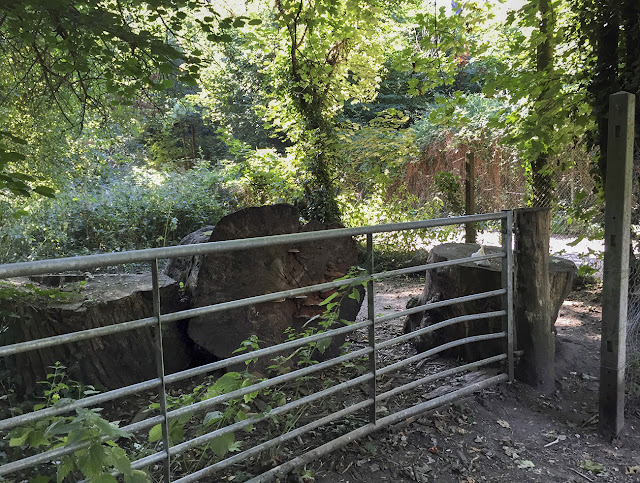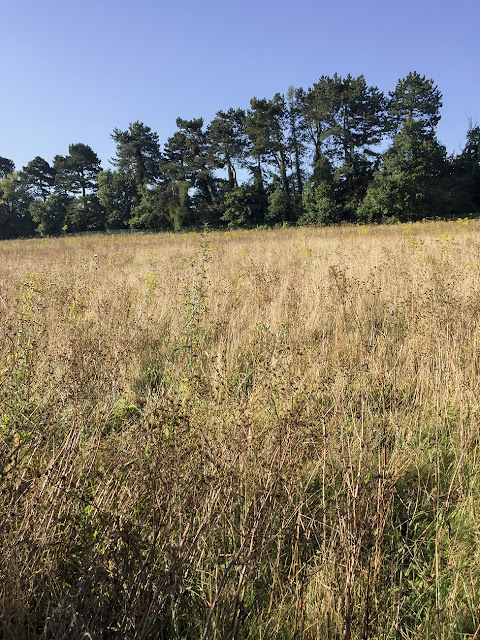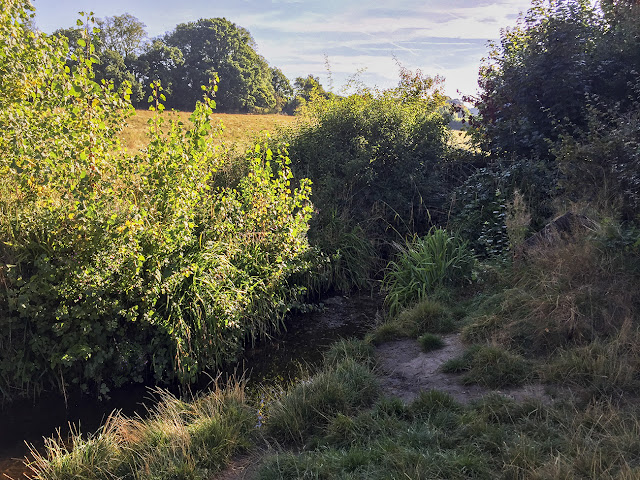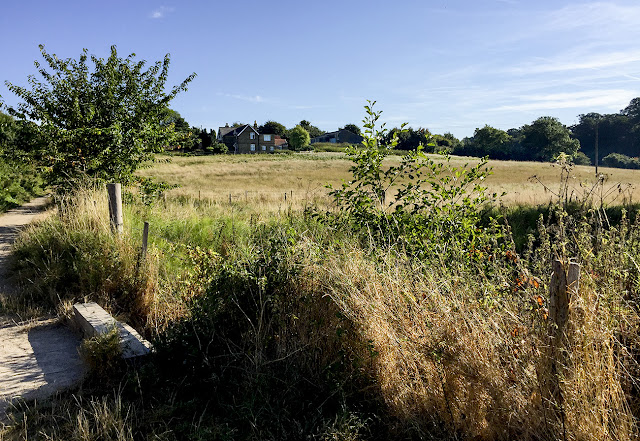 |
| Tong Farm. Walk around the Hawkwood Estate 09, 30 August 2016. |
This is the second part of a three-part walk around the Hawkwood Estate and the edge of Petts Wood, consisting mostly of iPhone photos taken on the way around.
Having walked alongside the Kyd Brook, I came to a T-junction. Up the slope to the left is Tong Farm, a working farm open to the public. The path up here also serves as a short cut back down from later in the walk.
 |
| Walk around the Hawkwood Estate 10, 30 August 2016. |
I turned right along this shaded path between fields, towards the railway.
 |
| Railside path. Walk around the Hawkwood Estate 11, 30 August 2016. |
Then left along the side of the railway, which is well fenced off. This path
looks dry and well-drained now, but in wet weather it is another row of mud puddles.
 |
| View across the railway. Walk around the Hawkwood Estate 12, 30 August 2016. |
The far side of the railway is populated by Rosebay Willowherb, Chamerion angustifolium, sometimes called Fireweed. It grows freely on disturbed ground and used to be common in bomb craters in London. I used to work over the road from what must have been just about the last undeveloped London bomb crater, near Ludgate Circus - it is now office buildings - and it certainly grew there.
 |
| Railway footbridge. Walk around the Hawkwood Estate 13, 30 August 2016. |
This footbridge would take you over the railway to Jubilee Country Park, which has its own wartime history. (*) I went around the steps and onwards.
 |
| Petts Wood sign. Walk around the Hawkwood Estate 14, 30 August 2016. |
This is the edge of Petts Wood, which gave its name to the neighbouring conurbation. Despite what the sign says, there are no bye-laws on its back. (I have a photo of the back, but I have left it out because it is boring, there being nothing there, so the photo numbers jump by one at this point.)
 |
| Wooden walkway. Walk around the Hawkwood Estate 16, 30 August 2016. |
The National Trust does not build walkways like this unless the ground is usually a sea of mud. Luckily, this has been a dry spell.
The gantry just visible at the top right is the last sight of the railway, as the walkway curves off to the left.
 |
| Petts Wood. Walk around the Hawkwood Estate 17, 30 August 2016. |
Up into woodland, now. The path is broad, and obviously must be used by a lot of people, but they are clearly not all here at once. I only came across half a dozen people on the whole walk, two of whom were running for exercise, and the others were walking dogs.
 |
| Remains of English bluebells, Hyacinthoides non-scripta. Walk around the Hawkwood Estate 18, 30 August 2016. |
Most of the low woodland plants flower really early, to get the benefit of spring sunshine before the trees' leaf canopy blocks it all off. This is all that remains of bluebells by this time of year.
 |
| Dry stream bed. Walk around the Hawkwood Estate 19, 30 August 2016. |
This is known as the wet part of the wood. This dry runoff watercourse just emphasises again that we have been having a dry spell. All that dry mud is usually wet mud.
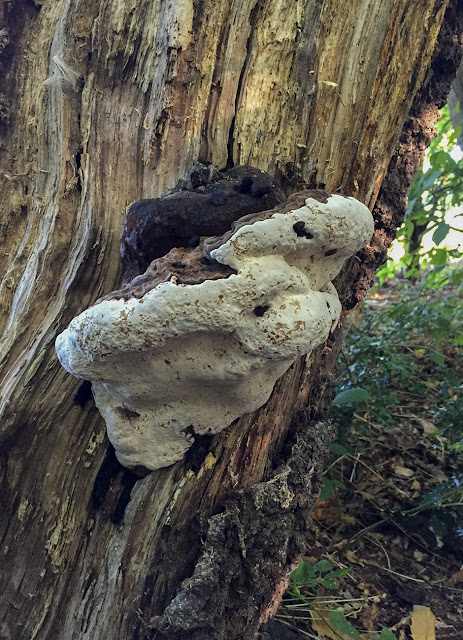 |
| Ganoderma fungus. Walk around the Hawkwood Estate 20, 30 August 2016. |
This is a tough fungus, hard to the touch, genus Ganoderma, growing on an old dead stump. The white surface is composed of the pores for spore dissemination and can be easily marked.
 |
| Soldiering Field. Walk around the Hawkwood Estate 21, 30 August 2016. |
The path turns out of the woods and between two fields. The field on the right is known as the Soldiering Field. It is where volunteers mustered and drilled in the 19th century. Here is a view from the other side in 2014:
 |
| Soldiering Field, Hawkwood Estate, 30 July 2014. |
Along that path I could not resist taking a closeup of a hoverfly.
 |
| Hoverfly, Syrphus species. Walk round the Hawkwood Estate, 30 August 2016 |
Adult hoverflies eat pollen, and this one is steadying an anther with its left foreleg while it uses its proboscis to gather the tasty food.
Into the trees again at the far side, where there is an area of heath. Several plots in Petts Wood have been scraped and seeded with Ling heather.
 |
| Walk around the Hawkwood Estate 23, 30 August 2016. |
This is the same species that covers the hills of Northumberland and Durham, where I grew up.
 |
| Rowan tree, Sorbus aucuparia. Walk around the Hawkwood Estate 24, 30 August 2016. |
A left turn here takes you downhill. Rowan, or Mountain Ash, is the most showy of the early berry trees and occurs in many woods. Our two native Viburnums, Guelder Rose and Wayfaring Tree, are also full of berries but are smaller, and usually found on chalk. Spindle is showier, but later, and also usually smaller.
Next time, back to the starting point!








